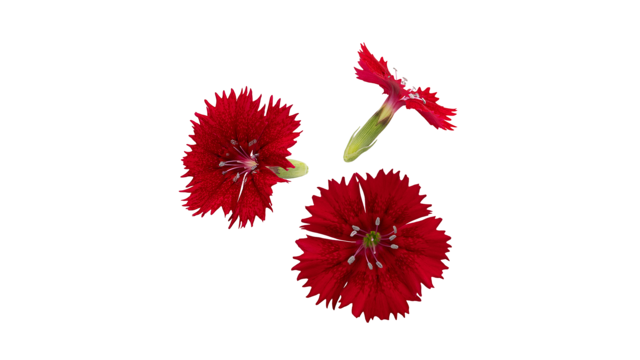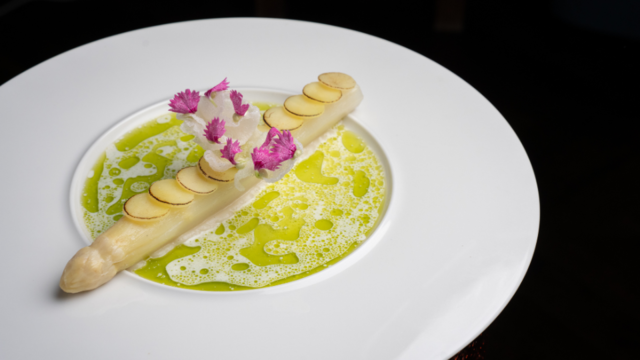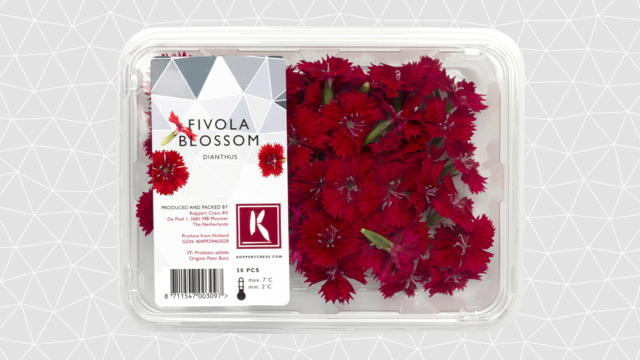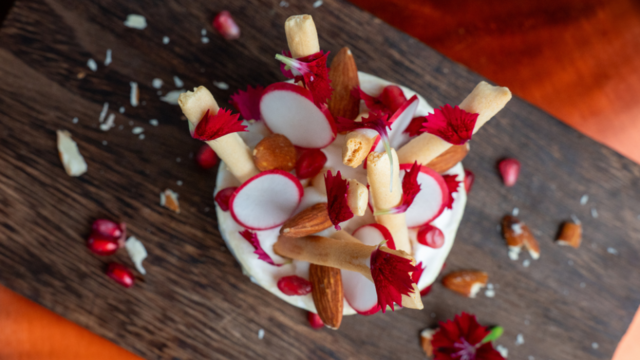







Fivola Blossom, Spicy bitter, floral
Category: Flowers
Fivola Blossom has a pleasant spicy bitter, floral, clove-like taste, especially the more fragrant varieties, and are ideal for decoration.
- Origin
- Asia
- Taste / Aroma
- Spicy bitter, floral
- Season(s)
- Spring, Summer, Autumn, Winter, BBQ, Christmas, Easter, Lobster, Mothersday, Oyster, Pumpkin, Rhubarb, Strawberry, Valentine's Day
- Storage
- Cold, 2-7 °C
Taste
Fivola Blossom has a pleasant spicy bitter, floral, clove-like taste, especially the more fragrant varieties, and are ideal for decoration. The small but showy and often fragrant flowers are mostly pink to deep rose, with some being red, purple, white, or yellow.

Taste Friends
Fivola Blossom is one of the popular edible flowers which has been used from ancient times. They are used worldwide in culinary preparations and decorations and are appreciated because of its bioactive compounds.
Because of its character the flowers can be used in various dishes like salads, sandwiches, jellies, pies and the aromatization of vinegar and wine. Special discovery is that the petals are one of the ingredients of the famous French liqueur Chartreuse.

Origin
Fivola Blossom, commonly known as rainbow pink or China pink is a herbaceous perennial plant growing to 30–50 cm tall native to northern China, Korea, Mongolia, and southeastern Russia.
The cultivation of Fivola Blossom flowers can even be traced back to Ancient Greece. These flowers, highly regarded for their ornamental beauty, were even used as food flavouring in various culinary preparations. To this day, they continue to be utilized as an actual ingredient in several recipes.
The flowers have been used for over 2,000 years in Chinese traditional herbal medicine and is known as ‘Qumai’. The whole plant is a bitter tonic herb that stimulates the digestive and urinary systems and also the bowels.

Availability
Fivola Blossom is available all year round and can be kept at a temperature of between 2-7°C for up to seven days. Produced according to socially responsible cultivation methods, Fivola Blossom satisfies hygiene standards in the kitchen. The product only needs to be rinsed before use as it has been cultivated cleanly and hygienically.
- Sweet
- Salty
- Sour
- Bitter
- Umami
Specifications
- Taste
- Sweet, Salty, Sour, Bitter, Umami
- Cultures
- African, Alpine, Asian, Chilean, Chinese, Creolic, Dutch, French, Greek, Indian, Japanese, Korean, Mediteranean, Nordic, North American, Oriental, Persian, Peruvian, Portugese, South American, Spanish, Thai, Turkish, Oriental
- Usage
- Covering, Decoration, Drying, Gel, Pickling, Smoke
- Colors
- White, Green, Pink, Purple, Red, Yellow
- Dishes
- Breakfast, Cheese, Cocktail, Crustaceans, Dessert, Fish, Fruit, Grill, Lunch, Pastry, Poultry, Salad, Starter, Sushi, Vegetarian, Vegetables, Water
- Taste Friends
- Mozzarella, Cheese (others), Chocolate, Prawns, Crustaceans others, Cod, Monkfish, Salmon, Fish (saltwater), Fish (freshwater), Shellfish, Apple, Apricot, Berries, Cherry, Citrus, Coconut, Corn, Cucumber, Figs, Grapefruit, Grapes, Kalamansi, Lemon, Lime, Mandarin, Mango, Orange, Passion fruit, Peach, Pear, Peas, Pineapple, Plum, Pomegranate, Pumpkin, Red fruit, Strawberry, Watermelon, Deer, Rabbit, Chives, Fennel, Mint, Parsley, Anise, Beans, Goat, Lamb, Almonds, Hazelnut, Pistachio, Walnut, Duck, Goose, Pheasant, Pigeon, Quail, Turkey, Poultry (other), Scallop, Black pepper, Cinnamon, Cumin, Vanilla, Asparagus, Avocado, Beetroot, Celery, Carrot, Cauliflower, Chicory, Ginger, Kale, Kidney beans, Lettuce, Onion, Potato, Radish, Rhubarb, Sweet potato, Couscous, Egg, Liquorice, Olive oil, Ponzu, Pumpkin seeds, Seaweed, Soy sauce, Sugar, Tofu, Yuzu
- Latin Name
- Dianthus
- Synonyms
- essbare Blüten, Dianthus, Anjer, Carnation, China Pink, Rainbow Pink, Caryophyllaceae, Petals, Bloemen, eetbare bloem, eetbare bloemen
Related Recipes
Gastronomic Masterpieces